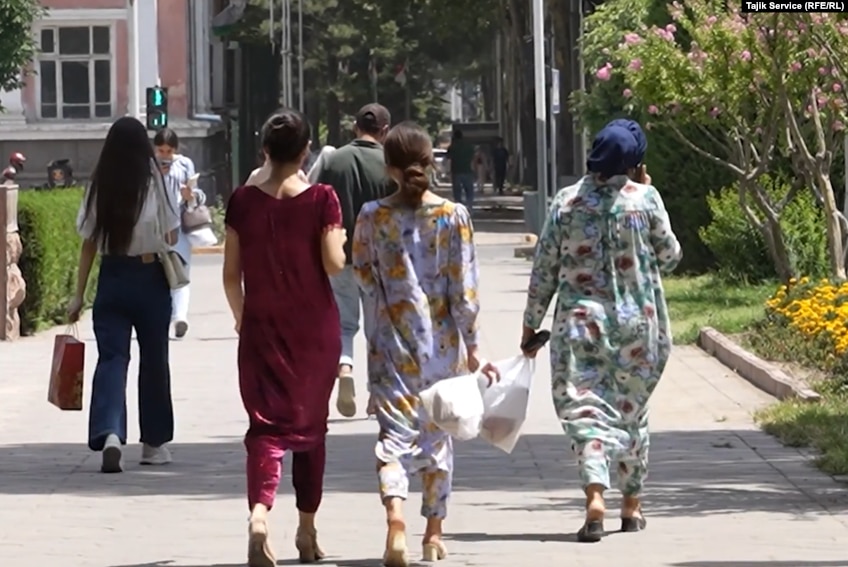Women’s clothes are high on the government’s agenda once again in Tajikistan, where authorities and Islamic leaders are working on new guidelines on what women should wear to work and during their leisure time.
The new dress code — the second of its kind in six years — is expected to be made public in the coming days, and a special event is reportedly being planned for the capital, Dushanbe, in August to showcase compliant clothes.
Sulaimon Davlatzoda, the head of the state Committee for Religious Affairs and the Regulation of Traditions, told a press briefing in the capital this week that “a joint task force of the Culture Ministry, the Women’s Committee, and the Religious Affairs Committee is working together to determine what clothes are most compatible with our national values and traditions.”
The new dress code comes after Tajikistan officially issued a ban in June on “clothes alien to Tajik culture,” a term widely used by officials to describe Islamic dress, which they treat as an outward sign of potential religious extremism.
Earlier this week, the Central Asian country’s state-backed Islamic Council of Ulema issued a fatwa — a religious edict — against “black clothes” as well as “tight-fitting and see-through” garments for women. In Tajikistan, the term “black clothes” tends to be a euphemism for the Islamic hijab.
The July 26 fatwa proclaimed that the color of black is not compatible with “our national and geographical characteristics.”
Echoing the government’s long-standing position on female clothing, the fatwa also promoted a national costume for Tajik women, which consists of a dress, trousers, and a kerchief.
The fatwa explained that the three-piece was fully in line with the Islamic practice mandating a woman cover her entire body, with the exception of her face, hands, and feet.
‘We Got The Message’
Tajik President Emomali Rahmon, who has been in power for more than 30 years, has been criticized by rights groups for clamping down on independent media, political pluralism, and also religious freedom. Religious beliefs and practices that deviate from the state-mandated norm are often seen by the authorities as a threat to Tajikistan’s stability and security.
Tajiks, especially those who wear the hijab, say they believe that the June hijab ban, the latest fatwa, and the upcoming guidelines on women’s clothing are a “needless, excessive step.”

“Black was already banned,” said Munisa, a nurse in a state hospital in a northern city who didn’t want to give her full name. She was referring to the state Religious Committee’s 2017 statement that prohibited wearing black at funerals.
Instead, the statement urged Tajik women to stick to the local tradition of wearing blue to mourn their dead.
“Nothing is new about the hijab ban, either. It’s been [effectively] in place for a decade at least,” Munisa said.
“We got the message already. There’s no need to keep repeating it, with new laws,” the 40-year-old nurse said.
Like many Tajiks, Munisa dismisses the fatwa against tight and see-through dresses as a smokescreen, saying the real target is Islamic dress, which the government considers “alien” and a threat to the secular government. For example, previous bans on miniskirts and plunging necklines have never been enforced.
In predominantly Muslim Tajikistan, a country of nearly 10 million people, the authorities’ campaign against the Islamic head scarf began in 2007 when the Education Ministry prohibited the hijab — and miniskirts — at schools and universities.
The ban eventually expanded to workplaces, and officials and police conducted raids to ensure its compliance.
Many hijab-wearing women faced a tough choice between their religious and cultural beliefs and their careers. Some quit their jobs or studies, while others — like Munisa — swapped their Islamic head scarf for the traditional kerchief.
Tajik men have also fallen afoul of government edicts in the past, with the authorities seeing them as suspect because of their long or bushy beards.
In 2015, a regional police chief in the southern Khatlon Province announced that nearly 13,000 men “with long and unkempt beards” were rounded up in the streets and bazaars over the course of the year and had their beards “brought to order.”
A high-ranking government official warned Tajik bloggers in 2023 that promoting beards might be interpreted as “an expression of solidarity with terrorist groups” and presents “a threat to national security.”

In 2018, the Culture Ministry published The Guidebook To Recommended Outfits In Tajikistan, which outlines acceptable designs, colors, and fabrics for clothing.
While the guidebook encouraged women to wear the Tajik national three-piece costume, for the office it suggested that they wear Western-style clothes, albeit with more modest necklines and hemlines.
It is not clear if the upcoming dress code will supersede the previous guideline.
New Crackdown
Some Dushanbe residents have complained that the recent official ban on “alien” clothes has prompted the authorities to crack down.
In Dushanbe, a group of hijab-wearing women were rounded up on May 22 by law enforcement officers and representatives of the local women’s affairs office and taken to the police station.
One of the women later told RFE/RL’s Tajik Service that their fingerprints and mugshots were taken and they were made to promise not to wear “alien” clothes ever again, before being released the same day.
On May 23, police in the capital’s Shohmansur district briefly detained 13 men with bushy beards and demanded that they shave. Police warned them they “will be arrested if caught again with long beards,” one of the men told RFE/RL.










